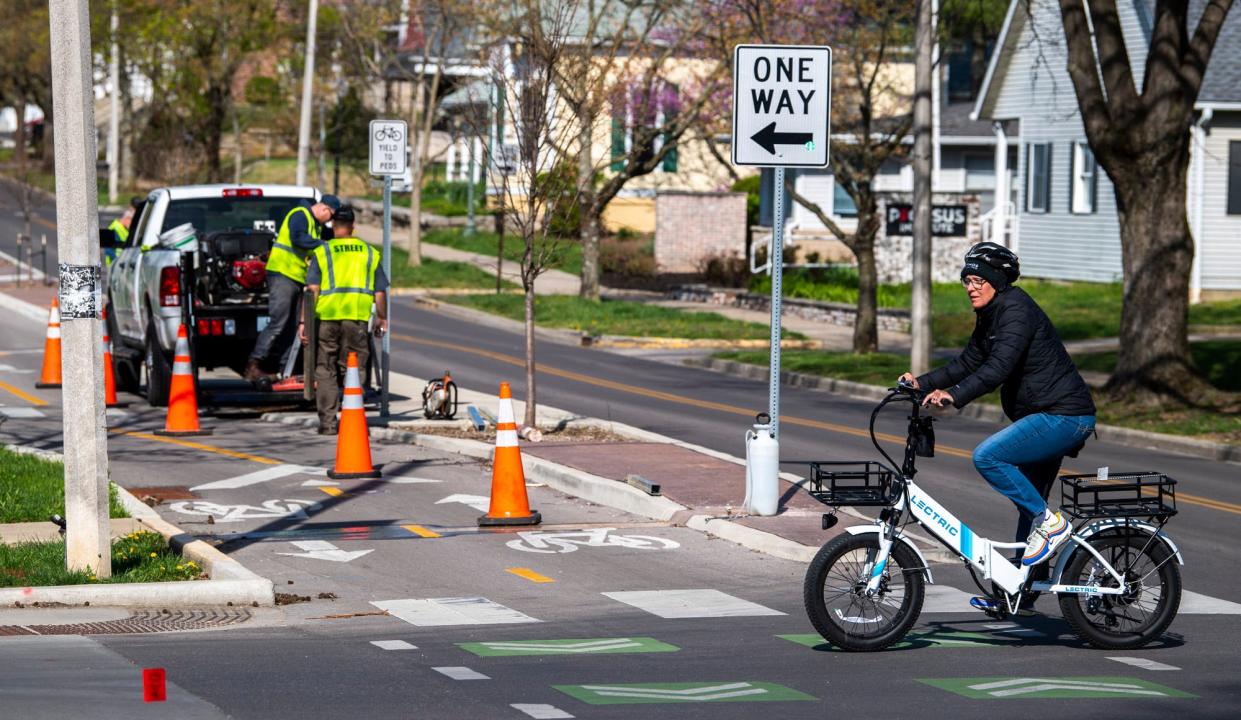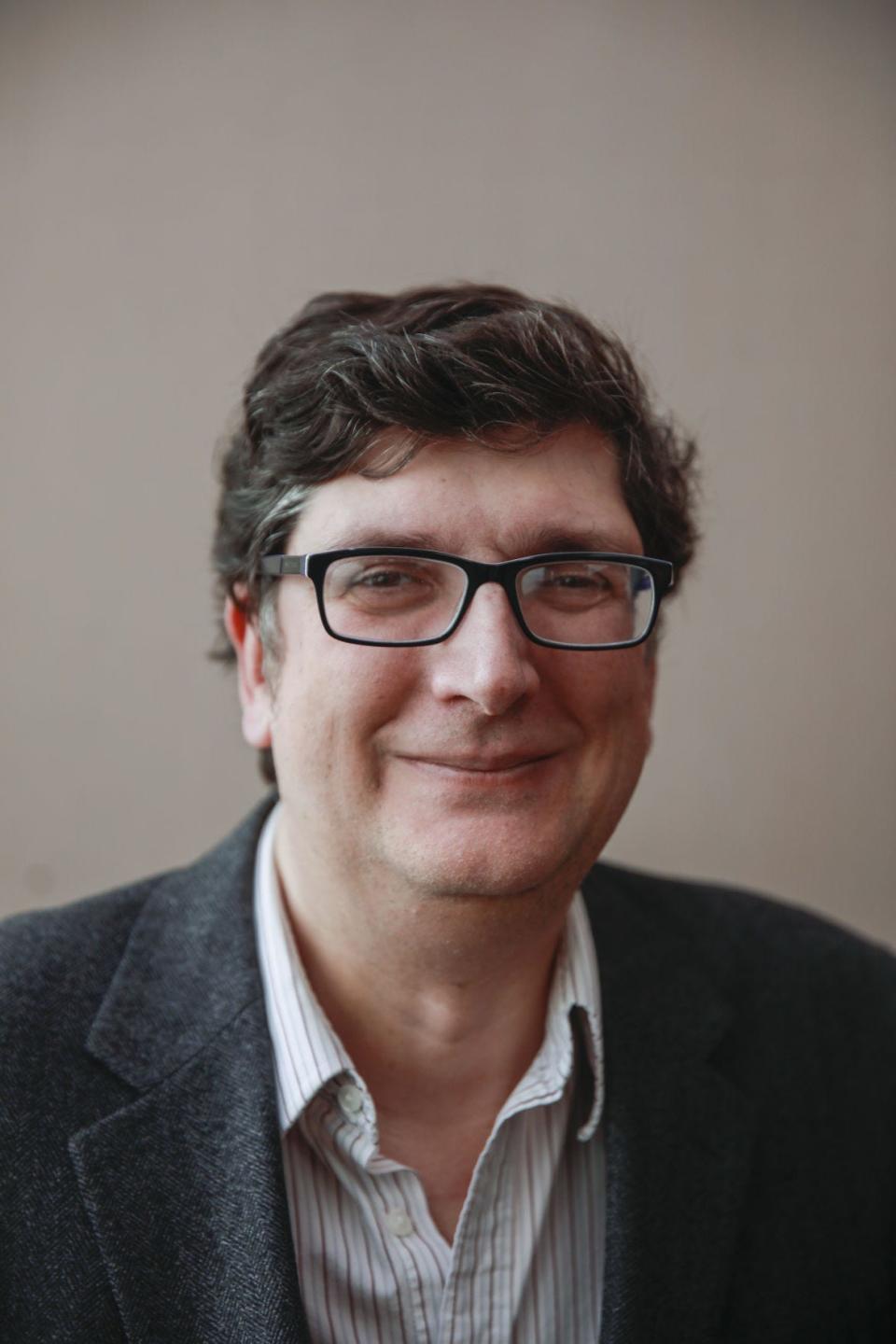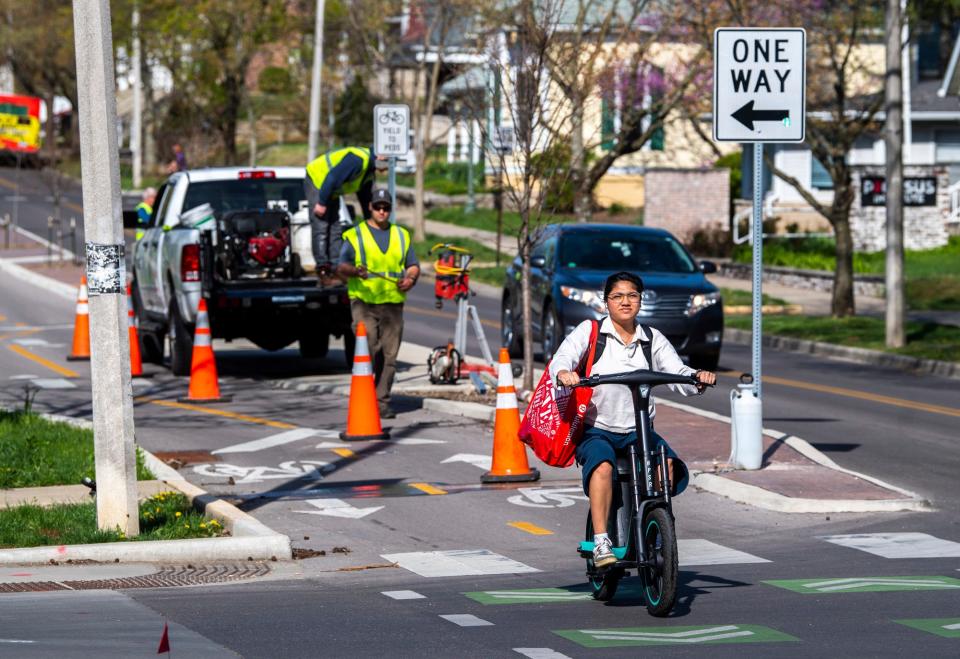Bitterly split Bloomington council votes to add stop signs along 7-Line bike path

- Oops!Something went wrong.Please try again later.
A bitterly divided Bloomington City Council has voted to reinstall stop signs at three more cross streets on the 7-Line, as members accused colleagues of being out of step, favoring the interests of drivers over those of cyclists and gaslighting.
The 5-4 vote — among now familiar ideological lines — echoed council members’ prior disagreements about whether to give greater deference to drivers, pedestrians or cyclists. The sometimes acrimonious back-and-forth between council members also laid bare some sharp intra-party disagreements — all council members are Democrats — with members sometimes trying to impugn one another’s motives rather than focusing on the validity of their arguments.
Council member Stephen Volan described the stop sign reinstallation plan as a way to “ruin” the 7-Line, the city’s primary east-west bike corridor. Council member Dave Rollo, who made the proposal, said he asked for the stop signs to be reinstalled out of concern for pedestrian safety.
A stop sign where none is needed? Lessons in politics, persistence, privilege.
The city completed the two-way protected bike path on the south side of Seventh Street with much fanfare — and criticism — in 2021 to connect the B-Line, downtown, Indiana University campus and eastside neighborhoods and to “make the street safer and more accommodating for a mix of transportation options.”
The project included the removal of stop signs along the corridor to ease traffic flow. Before the 7-Line project, drivers and cyclists going east or west on Seventh Street and going north or south on cross streets had to stop at stop signs. The 7-Line project removed stop signs for east/west traffic.
Rise in accidents on Seventh Street prompts re-examination

An increase in accidents after project completion prompted Bloomington City Engineer Andrew Cibor this year to suggest the city reinstall stop signs at five cross streets along the route — Dunn, Washington, Lincoln, Grant and Morton.
However, the local traffic and bicycle & pedestrian safety commissions both opposed Cibor’s plan — except for Dunn Street — in part because, members argued, it would punish cyclists by slowing their east-west progress — sometimes on inclines — even though the problem lies with inattentive north-south drivers and speeding or inattentive east-west drivers.
More: 29 accidents on 7th Street prompt Bloomington to backpedal, reinstall stop signs
Cibor, saying the issues were complicated, acquiesced and issued a 180-day order to reinstall stop signs only at the intersection of Seventh and Dunn streets. As that order was soon to expire, he asked the council last week to make the installation permanent.
Cibor said during the meeting the changes on the 7-Line had increased bicycle traffic by 25% — excluding scooters — and that pedestrian activity had increased as well. In addition, he said the installation of the stop sign at Dunn and Seventh streets had reduced crashes there and the number of crashes along the corridor had stabilized.
Pedestrian safety — or ruining a protected bike lane

Rollo introduced an amendment to Cibor’s plan to require the city also reinstall stop signs at the intersections of Seventh and Lincoln, Morton and Washington streets. Rollo said he had heard, especially from older constituents, that they did not feel safe enough to cross Seventh Street.
Volan and council member Matt Flaherty said by that logic, the city should, in the interest of pedestrian safety, put up stop signs all over town.
Volan also said the amendment’s supporters were favoring motorists over cyclists and the plan would “ruin” the 7-Line. However, council member Susan Sandberg said she also had heard from cyclists that they would like additional stop signs. She rejected the idea that supporters of Rollo’s plan were siding with cars over bikes.
All three community members who spoke on Rollo’s plan said they opposed it.
Pauly Tarricone, a member of the city’s bicycle and pedestrian safety commission, said making the stop signs at Dunn and Seventh permanent was acceptable, but Rollo’s last-minute proposal to also reinstall stop signs at three other intersections showed that he was not interested in seeking input from the population most directly affected by his proposal: students who were busy taking mid-term exams.
“Bicycles will generally not stop at these intersections nor does it make sense for them to do so,” Tarricone said. “The likelihood of collisions between bicyclists and other vehicles increases as they spend more time in an intersection.”

Volan said the lack of public comments supporting Rollo’s plan indicated supporters of his amendment were “out of step with Bloomington.” He accused Rollo and his supporters of using pedestrian safety as an “unfortunate excuse for continuing to allow cars to cross” in the city’s sole example of a successful protected bike lane.
He said he was “bitterly disappointed” in some of his colleagues who were allowing the feelings of some of their constituents to trump data and the professional insights from the city’s engineer and two local commissions.
“We should not let people’s feelings be the final (arbiter),” he said. “Why bother to have a comprehensive plan if we’re just going to … ignore it.”
Sandberg said she didn’t appreciate the “gaslighting” — a form of psychological manipulation that involves presenting false information to a victim with the intent of making them doubt their own memory and perception. Data are important, she said, but so are the feelings of the people with whom public officials communicate.
“We are not destroying the 7-Line,” she said.
Council member Jim Sims said he was “offended” by Volan’s comments, saying that disagreeing with someone doesn’t equate to being out of step.
Council member Kate Rosenbarger, who opposed Rollo’s plan, said the council’s focus on the intersections on Seventh Street diverted attention from many other intersections that more desperately need intervention.
Rosenbarger, too, vented her frustration, saying she has told people not to join the city’s boards and commissions because the council usually ignores them.
Council President Sue Sgambelluri appeared taken aback by the vitriol.
“Wow. Just wow,” she said as the discussion concluded.
Rollo, Sandberg, Sims, Sgambelluri and Ron Smith voted in favor of the additional stop signs, with Volan, Flaherty, Rosenbarger and Isabel Piedmont-Smith opposing.

Volan: Next Bloomington council will remove the 7-Line stop signs
Volan predicted Rollo’s “bad policy” would be undone by the next council in 2024.
City elections will be in November. Four of the five council members who voted for Rollo’s plan won’t be on the council come January. Only Rollo will remain. Three of the four who opposed his plan will remain — though Volan, too, will not serve on the next council.
One likely new member, Hopi Stosberg, who, barring a Republican upset, will replace Smith, used the public comment period to also oppose Rollo’s plan. Stosberg said the additional stop signs would make the corridor “less bike friendly,” as cyclists would be forced to stop going uphill as they’re heading west. She echoed the city’s commissions, saying Rollo’s proposal penalized cyclists more than the actual cause of crashes: motorized vehicles.
The Bloomington Bicycle Club’s safety coordinator said this week he likes Rollo’s plan and applauds the council for voting to reinstall the stop signs.
“The cycling community will be very happy with the additional stop signs,” Craig Medlyn said.
Medlyn lives near Lincoln and Seventh, rides the 7-Line several times a week and said he frequently sees accidents and close calls.
“Safety is the priority over speed,” he said.
While cyclists don’t have to stop at most intersections on Seventh Street when they head east or west, Medlyn said most cyclists approach every intersection with caution because they have to worry about inattentive north-south drivers blowing through stop signs or, if they’re turning onto or off Seventh Street, failing to yield to cyclists.
Medlyn said the corridor likely needs more work — perhaps making the road a one-way street — because firefighters have told him they avoid the street out of safety concerns, which, Medlyn worries, might increase response times to emergencies.
Cibor could not be reached this week to say when the stop signs would be reinstalled.
Boris Ladwig can be reached at bladwig@heraldt.com.
This article originally appeared on The Herald-Times: Bloomington council votes to add more stop signs to 7-Line bike path

